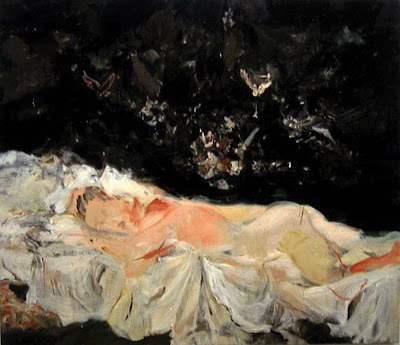Head VI, 1949
Oil on canvas 93 x 76cm
Museum of Modern Art, Scotland
29th August 2005
A special pilgrimage to Edinburgh to see this exhibition of portraits and heads, many of which I had only seen in reproduction before and I wasn't disappointed.
The first room contained many outstanding paintings including two that I have long admired, but only seen before in reproduction. "Head VI" is owned by the Arts Council and is a forerunner of what were to become the popes - a working of Velázquez’s portrait of "Pope Innocent X". It is the first image to include a pope as subject and probably the first use of his space frame in a painting. He sits in this ‘Eichmann’ box, mouth receding like a tunnel, gilded chair described by a few drags of paint, the tassel/pull cord dangling in front of his face, eyes and top of head obscured by a curtain of paint dragged over the top.

The paint is applied very sparsely with lots of canvas showing. Paint thick and opaque, looks very chalky, like there is no oil in it at all! Canvas is not primed. A very simple palette of Episcopal purple mixed with white, a golden yellow for the throne, the darks for the curtains and some bluish greys in the mouth. The colour in this reproduction is a little redder than the painting.
It is well reported that despite the appeal of the Velázquez portrait, he didn’t see it in the original until 1990[1]. Astonishing really as the reproductions convey no hint of its freedom of handling, yet Bacon’s work is incredibly loose.
Taking this as his starting point, Bacon essentially grafted a very graphic photographic or filmic image onto the staid Baroque prototype. The specific source for the pope’s gaping, screaming mouth, shattered pince-nez glasses, and blood-dripping eye is a black and white still from Sergei Eisenstein’s classic 1925 film, Battleship Potemkin.

While Innocent X directly confronts his papal audience with a confident, almost contemptuous gaze, Bacon’s pope would seem oblivious to observation since preoccupied by pain. Attired in purple vestments the subject is trapped in his ‘box’ and jolted into involuntary motion by external forces or internal psychoses. His face is partly veiled by curtains, maybe to suggest he is in the confessional. The sense of power and control of Velázquez’s Innocent is replaced by the involuntary cry of Bacon’s anonymous occupant of the ‘hot seat’, and we can only speculate whether he is being tortured or is a tortured soul.
In making this devastating image of The Pontiff, God's representative on Earth, screaming in pain, he attacks the principals of hierarchical order and spiritual authority that the Pope embodies, suggesting that either God doesn't exist or he has abandoned us to our own devices. I find this transformation of the Spanish artist’s confident client and relaxed leader into a screaming victim contemplating the loss of God very melancholic indeed.
Bacon remains an inspiration as to what can be achieved with paint and I was pleased I made the effort, it was a real privilege to see these works, many of which are in private hands.
[1] Sylvester, David Looking Back at Francis Bacon, Thanes & Hudson, London 2000 p42
©blackdog 2009




























